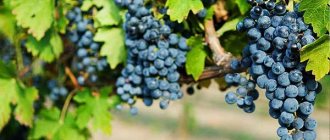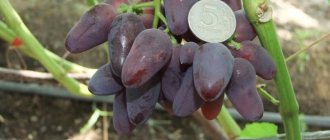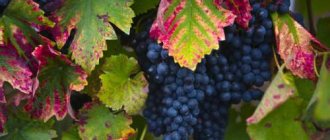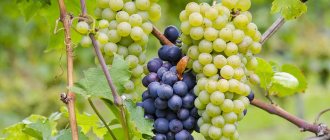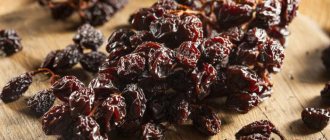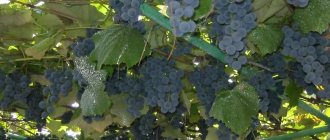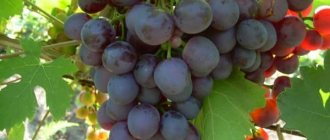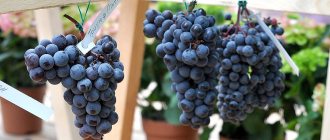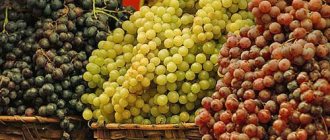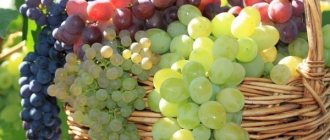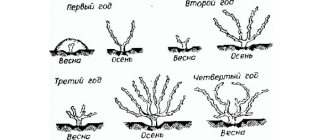Types of grapes that do not need to be covered for the winter
Grapes are a common crop in the home garden, giving your garden a beautiful appearance and tasty berries. The consumption of grapes has a long, rich history; they are consumed fresh and sent for processing. Wine, the oldest intoxicating drink, was obtained from grapes.
There are grape varieties that do not require shelter for the winter
What is the peculiarity of uncovered grapes?
Frost resistance and disease resistance are the result of the work of breeders. Grapes are a crop that falls victim to fungal diseases, so the development of disease-resistant varieties is a breakthrough in viticulture.
Uncovered grape varieties are a type of vine that, with the help of breeding work, has become resistant to pests and northern climatic conditions . Some time ago, it was not possible to grow the 10 best types of grapes in the north, since the crop did not survive in low temperatures. But today this problem is no longer relevant, because long-term work and crossing of different plant seedlings made it possible to obtain frost-resistant grape varieties.
|
There are dozens of frost-resistant grape varieties; they are grown in areas where the air and soil temperatures do not reach acceptable limits for the crop. Uncovered grapes include the following varieties:
- Isabella and Ontario.
- Lydia and Amethyst.
Isabella grapes - a popular frost-resistant variety
For summer residents of any region, it is possible to grow seedlings purchased by mail. It is enough to choose the most suitable seedling for the air and soil temperatures of a particular region. It cannot be said that each variety is endowed with only positive features, because for every plus there is a minus.
Vineyards are grown in two known ways: from seeds or seedlings. Planting a one-year-old seedling is a common type of plant cultivation. Its popularity is associated with a reduction in the ripening time of the crop and a greater likelihood that the plant will take root on the site.
Seeds, if you follow the recommendations for care and cultivation, can produce strong sprouts. But the effort spent on care will be greater than planting a seedling ordered by mail.
In order for the grape cutting to take root, you need to start preparing the site in the fall:
- Dig a hole and clear it of weeds.
- Fertilize the soil with organic fertilizers and sand.
- The soil should be fertile with moderate acidity.
- To prevent the soil from being too clayey, it is mixed with sand.
Integrated sustainable mail-order grape varieties are grown in the same way as all other varieties. In order to receive the grape harvest by mail, it is provided with access to light and protection from draft winds. Since uncovered varieties can be grown in northern climatic conditions, warmth is not the most primary need, but it is better to plant in the south of your site.
Ontario grapes are well adapted to cold winters
Gazebo made of grapes, design features
Hedges and arbors made from living plants are a popular way to place plants in landscape design. Lightweight architectural structures made of metal, which represent a frame along which grapes climb, are a practical and inexpensive structure that can be made independently in a fairly short time. It is the metal gazebo that will serve for a long period, optimally serving as a support for the vine.
Such a gazebo can be either a seasonal structure (which is assembled at the beginning of the season and folded at the end), or a stationary one, standing year-round on a solid foundation.
Depending on the design features, the gazebo can have different shapes and designs:
- Arched design;
- Domed;
- Arbitrary design;
- Pergola;
- The design is in the form of trellises connected to each other by a canopy;
- In the form of an extension to the house;
When you plan to build something like a do-it-yourself grape gazebo, at the initial stage you decide on the type of construction of the structure and its functionality. If you need a structure for relaxation and gatherings with friends, standing separately from the building, then it is better to choose a dome or tent structure and install it a little away from the house.
If you need a low-cost option that can be built quickly, then a structure that will use the house wall as a support is suitable.
Gazebos for grapes can be made not only in various types of design, but also from a variety of materials. It can be a wooden structure, metal, or a combined type using brick and other materials.
The most common option is metal gazebos, which are characterized by strength, durability, practicality, ease of construction and low cost.
It is not difficult to build such a gazebo. To do this, you need to decide on the construction site and draw up a sketch of the structure, indicating the dimensions. Afterwards the amount of required building material is calculated.
For work you will need the following tool:
- Yamobur;
- Welding machine;
- Pipe bender;
- Roulette and building level;
- Drill;
Consumables required for construction:
- Pegs that are convenient for marking the territory of a future building;
- Metal profile (the cross-section is selected depending on the size of the structure and the type of load on it);
- Metal wire;
- Concrete mixture for the foundation;
- Metal primer and paint;
- Grape seedlings.
At the initial stage, the area for the future gazebo is marked out, and holes are drilled to install the frame (depth of at least 0.5 meters).
Profile pipes are inserted into the prepared holes, leveled and filled with concrete mixture. After the concrete has completely hardened, further installation of the frame is carried out, fastening the transverse elements, the roof, and metal wire is stretched along the entire perimeter, in increments of 30-35 cm.
After installation is completed, the seedlings are planted. An option for building a small gazebo for grapes with your own hands is shown in the video
Types of uncovered grapes
There are about twenty varieties of planting material uncovered for the winter. Among them there are more popular types. The Isabella variety was bred by American breeders. It was introduced to our lands in the fifties of the twentieth century.
Isabella berries are well-known among both experienced gardeners and beginners. Its functional purpose: fresh consumption, juice production and processing for wine.
Many types of wines are prepared using this type of berries. Tolerates temperate climates and produces dark berries. Isabella's aroma cannot be confused with other species, and the taste contains sourness.
The weight of one bunch reaches one hundred and fifty grams, the berries are arranged tightly. The variety has a late ripening period. Isabella's advantage is her predisposition to long transportation and endurance in winter.
Lydia grapes are used for making wine and for decorative purposes.
The Lydia variety produces crops starting in September. Lydia's berries are long in shape and pale pink in color. The variety has a thick skin, and the clusters themselves are large, but with sparsely spaced berries. The variety is resistant to diseases, pests and insects.
Lydia's vine is also intended for the decoration of the gazebo. Grape vines are often used to decorate gazebos. Growing grapes for the purpose of entwining a gazebo with vines is popular; it is mostly used to decorate a garden in a country house, and is also used to decorate gazebos in catering establishments.
The Amethyst variety has the highest resistance to winter and disease. The amethyst variety should be grown in the north, since the grapes can grow at temperatures down to -35. The Amethyst vine grows strongly, for this reason the seedlings can be used to decorate the gazebo.
The gazebo seedling ripens by the last days of August. The weight of grape bunches reaches seven hundred grams.
The 10 best varieties of uncovered plants: Delight, Victoria, Isabella, Amethyst, Ontario, Arcadia, Laura, Talisman, Strashensky, Negrulya.
Amethyst grapes do not require shelter for the winter
Arched grapes on supports
Another small architectural form is the arch, which consists of two supports connected by a rounded vault. They are usually located above the paths or at the entrance. They serve to pass under them. Their height at the top point is 2.2 m, and the distance between the supports is equal to the length of the track, plus 30 cm on each side to strengthen the supports. Grapes are usually placed on the outer sides of the bases.
Often the arch is located in an open place, not protected from the wind. For this reason, it is important to select varieties that are resistant to drafts and frost, since they overwinter without shelter. These include “isabelle” hybrids of American varieties, but in addition to them, Victoria, Agate, Beauty of the North, and Unique Kishmish are successfully grown.
Tip #1. To obtain a harvest on decorative supports, it is better to use early ripening varieties: Early Pineapple, Golden Muscat, Armalaga, Balabanovsky. Buffalo, Wilder and others.
Caring for the variety
If a gardener decides to grow one of the 10 best grape varieties with high winter resistance and disease resistance, he can order the seeds of the variety of interest by mail. The 10 best varieties, no matter what type you choose, need care. The main part of care that makes grapes disease resistant is pruning. Shaping the vine allows it to be correctly guided along the arbor or installed support.
10 species that do not require shelter for the winter and disease-resistant varieties are fertilized and watered at certain intervals. 10 winter-resistant varieties, seedlings or seeds of which you ordered by mail, are pruned in three seasons: autumn, spring and summer. The only time without pruning is winter.
In order not to harm the winter-hardy seedling, pruning should be done before or after sap flow. Areas that have served their purpose and that have dried out must be removed.
Previously, there was talk about growing grape varieties that can withstand winter without shelter and are disease-resistant using seeds. They can be purchased by ordering by mail or going to a specialized store. Some varieties that do not need to be covered for the winter can be ordered online, and delivery will be sent to you by mail. Such seeds must first be checked for germination.
Empty seeds float in salt water. Seeds sent by mail that remain at the bottom will sprout. To get seedlings, you need to get seedlings from seeds.
For this purpose, they are placed in moistened gauze, which is kept moist for a week. After the roots appear, seeds received by mail or purchased in a store are planted in cups. As they grow, varieties that are not covered for the winter must be transplanted into a larger container.
The best wine varieties for the Rostov region
It is worth noting that if the southern non-covering varieties do not require measures to protect the vines at the onset of winter, then in the Rostov region a covered type of grape growing is used. In this case, the vine is covered with soil during the winter and dug up again in the spring.
These varieties include those listed below.
- Tsimlyansky black.
- Purple early.
- Rkatsiteli.
- Northern Saperavi.
- Sibirkovy.
- Riesling.
It is especially advisable to focus on winemaking in southern countries. The special climate and soil composition make it possible to cultivate varieties with a truly unique taste. One of the most famous is the production of wine products in Uzbekistan.
The best grape varieties grown in this country include the following:
American wine grape varieties also deserve attention. It is worth knowing that the United States has a fairly highly developed wine industry.
The most popular grape varieties of this country include the following:
- Cardinal;
- Kish-mish White Flame;
- Kish-mish Red Flame;
- Kish-mish Summer Royal;
- Manuka Black;
- Red Globe.
The most frost-resistant grape varieties
The heat-loving grape crop comes from countries with a lot of hot days. However, thanks to the efforts of breeders, amateur winegrowers can grow sweet, sun-filled berries in Siberia and the central part of the country.
Uncovered grape varieties can withstand winter thaws and frost strikes without compromising product quality and plant health. The number of crop varieties that do not need to be covered for the winter is large and allows you to make a choice according to individual preferences (taste, sweetness, aroma, color) and agrotechnical characteristics (disease resistance, transportability, keeping quality).
The best varieties of wine grapes
When considering the types of existing varieties, it is necessary to distinguish between technical wine grape varieties and table grape varieties.
The difference is that technical varieties are focused on preparing various products from fruits: juices, wines, raisins, compotes, and so on. The appearance of the bunch is not important to them. The most critical factors for them are the chemical and technical composition of the berries: the ratio of the mass of the berries to the mass of the bunch branch, the ratio of the mass of the pulp to the weight of the seeds, and so on.
Wine and table varieties are intended primarily for fresh consumption. They are distinguished by the aesthetic appearance of the berries and the bunch itself, as well as a fairly rich content of vitamins.
A brief description of wine grape varieties can be presented as follows:
- high juice content in the berry (75-85% of its weight);
- a small proportion of the weight of the ridge of a grape bunch in relation to the weight of the berries;
- chemical composition and physical characteristics of the fruit corresponding to its intended purpose.
Basically, it is based on these characteristics that it is determined which grape variety is wine.
When choosing the best varieties of this crop, it is necessary to take into account the exact conditions in which they will be grown. The most wine grape varieties are intended for cultivation in regions with a warm climate, where the length of time the crop will ripen will be maximum.
The type of soil in which it is planned to be grown also plays a role. Winemaking requires that the chemical composition of the berries used meet the existing requirements, so cultivating the required variety in unsuitable conditions will not bring the expected result.
Also, thanks to the efforts of breeders, frost-resistant varieties were developed. Crops intended for cold winters will be somewhat inferior in taste to southern varieties, but will ensure normal ripening even in cool climates.
Thus, varieties acclimatized to the conditions of the region where they are grown are suitable for wine.
Accordingly, the best varieties used for wine must be divided according to the regions where they are supposed to be cultivated.
Since a description of any of the existing varieties can be easily found on the Internet, so as not to overload the article with an abundance of information, below we will give only their names. More detailed information about the varieties of wine grapes and their characteristics can be easily found on the relevant resources. There you can also see photos of such varieties.
History of creation and features of selection of non-covering varieties
Selective work on breeding frost-resistant grapes dates back to the beginnings of the 20th century, when, under the leadership of the Russian breeder biologist I.V. Michurin, a group of scientists created samples of grape crops that could withstand frosts and return frosts without damage. The varieties Metallichesky, Russian Concord, Northern White are now called representatives of the Michurin selection.
It should be noted: the concept of uncovered grapes is quite arbitrary and depends on the geographical location of the place of its cultivation. In particular, in the Russian southern regions, almost all grapes are not covered in winter. In the middle part of the country, the same varieties in different areas may require shelter or do without it. Although, of course, the declared frost resistance is an important factor in the choice.
At the same time, uncovered grape varieties have many additional advantages: they are unpretentious in care, resist diseases, and calmly “tolerate” inept pruning. That is why experienced winegrowers advise beginners or those who just want to shade a gazebo or pergola to begin their gardening activities with them, while simultaneously collecting a “self-grown” harvest of grape clusters when there is no time to care for the vine.
Assessment of the degree of frost resistance
The difficulties in breeding frost-resistant grapes are based on the fact that the trait of frost resistance itself is not genetically determined, as is the case with many others, but is determined generally by the genotype of the plant. The extent to which a parent couple will pass on the required trait depends not only on the genotypes of both parents, but also on the strength of their heritability. To search for grape plants that are donors of frost resistance, breeders use various methods for assessing this property:
The most reliable are the first two of the above methods.
Geography of cultivation
The complex climate of the Ural region as a whole is constantly humid and cold, but the volume of snow cover and temperature tend to vary greatly from year to year. In these places, the uncovered Baltic species of Jadviga Gailiunas and Zilg, and the domestic selection Moscow Stable, Northern Early, Aleshenkin, and Jubilee of Novgorod have proven themselves to be excellent.
From the Ural Mountains to the Far East, winter-hardy hybrids based on wild Amur grapes can easily withstand severe frosts. They are characterized by small berries, but their taste and aroma are not inferior to well-known European species.
In any case, even the best uncovered varieties should be accustomed to frost gradually. In the first couple of years, a young vine needs shelter in the traditional way; in the third year, only one sleeve is left open.
Forum statistics
207036 Messages in 1634 Topics from 5593 Users. Last user: Amaya Last message: “Let's talk about the weather in Vash...” ( Today at 07:52:22 ) Latest messages on the forum.
Now on the forum
33 Guests, 8 Users
Users in the last 15 minutes: Grinya, Vlad51, Pioneer-2, Ivan Levin, y_fed, Elena Z, Natasha, Taker [Blocked] [Section Moderator] [Forum Moderator]
Maximum online today: 100 . All-time maximum online: 2758 (28 July 2021, 17:22:51)
Users who visited the forum in the last 24 hours
Total: 292
(Visible: 291, Hidden: 1) 1963, Grinya, vlad51, pioneer-2, Ivan Levin, y_fed, Elena Z, Natasha, Taker, freesia, Mst, marlin64, VeraNiK, gardener, Belgorodets, Oleg Filippov, Kenig, Marina Protasova , Nikolay 2, Vasily 53, rambo, ALEX, 77volt, Elvira2017, kvg, Evgeniy52, ElenkaF, sergei, Ser, Evgeniy 163, Lyubov S., Erem, Polyanina Ekaterina, kosmos, Yura, GALINA ANOKHINA, DorontsovPeter, ZaycevAS, Alex65, 64nikolay64, Vova Kapran, zsb, Polina77, spotlight, Mikhail Alekseevich, Svetla777, Quiet, Marshal, Nikolay S., therapist, Liza, Capricorn, lomakin1969, Alexander Vl., Andrey76, Slavka, Mikhail77, Tatyana B, Cherkessk, Eugene, Leonidych , vladimirM, yotmast, mers, Serg1707, SNovichek, hanter64, znakomij, Alexander K, Vardan, Sergey Fer, Anatoly Sivkov, Alexey V, Ilya 77, Andrey Gladilin, Tatyana A., in Astrakhan, Oksana Kopp, sem_en, Vladimir 153, skier, Igor Viktorovich, slavalimon, Primorets, OlgaOs, SANYCH, 31rus, mystic69, Andrey Tsvetkov, Buba, igor222, Nikolay Rex, Sergey 1965, Vladimir Buturlakin, DSW, psv1960, Dmitry 77, Vasily V., Vyacheslav03, Natalia Nikolaevna, Sergey Tashchiyan, Igor Sergeevich, alexsandr, Pioneer, nicson7, Elena Aleshchenko, Alexander-ask-34, Verona, Igor F., Henry, Yuri72, L.A.P., Gaivoronsky Yuri, Sergeevich, Sergey Chistokletov, Svetlana Streletskaya, Galinka, Alexey Deminov, Naumov Igor, Vyacheslav136, Gloomy, Katrin, AndSanych, Mikhno Alexander, Ded31, Vladimir ++, Lydia58, ALEXANDER BRYANSKY, Vladimir-kanevskaya, DIL, Amber7394, TITOVA LYUBOV, Linx, alexander66, Natalya M, Mikhail Fesenko, Amaya , Alexander71, Boris 1952, tsv, Maximilian, 25nata35, nadia, Igor_K, Alexander Kolesnikov, Pitko, weather forecaster, eSAa, cecet71, atseton, Alexander Smirnov, Vladimir Kostochkin, Vladimir Berdnikov, Gocha, LeXa_KoT, Sergey 61, Sergey Yuryev, alexss, Skif, Vladimir Kovba, dayton, Yuri Semenov, N.A. Sokolov, Pavlentiy, Sa-shura, Volgogradka, Dmitry Anatolyevich, Grandfather Igor, Andrey Lis, Bublichenko Alexander M, Marina Krymskaya, stenlly2010, irahelm, Vyacheslav Vladimirovich, Vladimir Shilov, Aprel, Dmitry Badaev, gheo55, Yagodka, Valentina Ivanovna, Kryn, oleg9f, DED2, Svetlana Korotina, Oleg Ivanovich Zavezen, Eduard., santra, L2k2m7n, Alexander48, Viknik, Andrey 31, m2d, Valery Rastorguev, soshnin yura, Amateur gardener , Galina, Vasily1111, Salex, Sergey Ko, Ramiz, Victor_, potap05, Yuri 36, VitalySD, Inna161, Vladimir Shcherbinin, Valerie, niy1, cfibr, Andrey68, kulol3, thanatos, Serzh1978, Realist, Artur53, max2008-01, LOZA, AlexanderD, Grandfather Young, Zayac, ketch, Rita, alx-74, Iv Iv, Alexander150, Igor K, Vasily Viktorovich, kdm57, Veniaminovich, Boris Sokolyansky, , vikbublik, neposny, Evgen, Victoria Aleksandrovna, Serezha 64, Wintel, Airbone, teri, Sergey Lomonosov, Khramov, serginio, Leonty Yarygin, Irina O., Nadezhda Grig, netolya, Saisan, Agryzkov Alexey, Vadi, Zinaida, Vadim, Alexander Taganrog, Sukhonos Sergey, Snezhinets, evgen_26, nau_63, Masha_gardener, Gennady163, krasnovlad1, Alexander Zinoviev, Roman Fedorovich, TIS, Alexey Sergeevich, Arnyusha, Zheka, Nurtas, kradievska, nick041, Valentina Medvedeva, Sergey43, Andrey S., Nikolay Lipunov, Vertuoz2, Vladimir VS, NatalyaMed, Kinna, Mikhail Michurinsk, alekcsan1, VALERY TAMB, Sasha57, MikhAf, Y_Azer, Andrey Beribesov, hunter1955, nut lover, Keys, Ivan Shmelev, Pestle, anton_slash, Nadymchanka, Sergey 31
Varietal diversity
Some frost-resistant grape varieties are universal: they are tasty fresh and suitable for the industrial and amateur production of a variety of drinks. Many of them are divided into:
- table - they are consumed fresh, unprocessed. They stand out for their pleasant taste, aroma and appearance;
- technical - for the production of juices, including for children, wines, and other drinks with and without alcohol.
Like any crop, grape varieties are early, mid-ripening and late-ripening.
Table varieties
Their taste and consumer qualities are excellent, so they are consumed mostly in unprocessed form.
Early ripening Muromets is one of the most delicious domestic table varieties. Pink bunches weigh up to a kilogram. Taste with a slight hint of nutmeg, sweet. The bush bears up to 7 kg of fruit. Tolerates frosts down to -26 °C “excellently.”
Pink pearls are high-yielding and versatile. Up to 8 kg of sweet brushes are collected from the bush. There are few seeds in the fruit. Overwinters on a trellis at -30 °C. It is not affected by fungal infections and has excellent resistance to pests. The percentage of ripened ones is at least 95%. Sugar content - 20-25%. The only weak point of Pink Pearls is that they are damaged during transportation.
The peculiarity of the Kishmish grape is its sweet taste and the absence of seeds. The weight of the bunches sometimes exceeds a kilogram. The berries are small but juicy. Keeping quality is long compared to other grape varieties. It is considered a table species, although sweet wine can be made from the fruits. In addition, the berries are dried. Kishmish’s homeland is hot Central Asian and Middle Eastern countries, but breeders have developed frost-resistant varieties. The most popular of them are:
Technical varieties
“Isabella” grape varieties make up a large share in the list of non-covering technical varieties - these are American grape varieties characterized by exceptional winter hardiness (so named after one of the prominent representatives - the Isabella variety). Having taken root in the middle zone, they bear fruit in clusters that are smaller than European varieties. Not all consumers like the special “strawberry” flavor of berries, but many varieties—Buffalo, Pineapple Early, Seneca, Ontario—have virtually none of it.
Promising winter-hardy technical grape varieties also include:
Wines from Muscat are especially aromatic, with a bright and powerful taste. The clusters are on average 10 cm in length. The fruits are round, approximately 1.5 cm in diameter. The pulp is juicy, the aroma is nutmeg. The variety was originally cultivated in warm, sunny France, Spain, Italy, and Portugal, but frost-resistant technical varieties were bred:
Uncovered, frost-resistant grape varieties are a real gift for gardeners, winemakers and consumers in countries with frosty winters. Their correct choice is the key to obtaining a vitamin harvest, delicious juices and sweet wine. Due to the fact that frosty winters are the norm in most of the country, they are in demand in both industrial and amateur viticulture.
What kind of gazebos entwined with grapes can look like?
Arbors entwined with grapes can be of different shapes - round, oval, quadrangular. Various ceilings are also acceptable - flat, cone-shaped, pyramidal.
The size of the gazebos for grapes depends on the layout of the plot or garden plot. When installing galleries, the height of the structure can be up to 2.5 m, the width - from 1.5 to 3 m.
Intermediate supports are installed at a distance of 3-4 m from each other. Transverse rods or wires are placed every 50-70 cm. The sides of galleries and gazebos can also be shaped, it all depends on the owner’s imagination.
These photos show the most beautiful gazebos for grapes:
For wall culture, a trellis is built on the wall. Crutches are fixed in the wall at a distance of 1.5 m with holes or a loop in the outer ends for wire or tsrukhs, which are placed horizontally.
The distance of the trellis from the wall is 20-25 cm. If the structure is wooden, the grapes are planted at a distance of at least 1.5 m from the wall for better ventilation.
Review of uncovered grape varieties
One of the most striking decorations of any summer cottage will be not only a luxurious garden of various types of fruit trees, but also a vineyard that produces not only a delicious harvest, but also simply a delight for the eyes. Although these berries are associated with the sunny Tuscan valley or the hills of Greece, excellent vineyards can also be grown in less-than-warm climates in other countries.
Especially for such latitudes, breeders have developed special varieties that are more resistant to cold weather, and some are even frost-resistant. There are about two dozen uncovered grape varieties. These are mainly hybrid individuals that grow and bear fruit normally in areas where the air temperature is not high enough for most of the year. This includes both Ukraine, large areas of it, at least, and the Moscow region.
Decorative frost-resistant varieties
Before you start choosing one or another grape variety to grow in the Moscow region, you need to decide for what purpose you need it.
Grapes can be grown as a decorative decoration for a garden or gazebo, for making compotes, wines, or simply as a delicacy.
So, for example, if you want to decorate a partition, pergola or gazebo, it is better to go for a decorative look.
For example:
- Northern Saperavi;
- Platovsky;
- Crystal.
These plants will not be able to please you with fruits, but they will certainly delight you with their elegant beauty.
Grapes from Moscow region, if grown correctly and know their detailed description, develop frost resistance and then they are not afraid of zoning and other areas. Uncovered grapes can very well decorate an arch, and how to do this can be seen in the photo and video. However, not all zoned varieties are suitable for this purpose.
The most popular varieties
There are more than twenty uncovered grape varieties, and each of them has its own advantages and disadvantages. However, all summer residents and winegrowers choose for themselves, as expected, the variety that will satisfy both taste requirements and will be unpretentious in care. In addition, over many years, gardeners working in the middle climate zone have determined the most optimal options for themselves.
If not the most popular, then at least one of these varieties can be called a guest from America - Isabella grapes. This variety was first brought to the territory of the USSR back in the mid-50s of the 20th century. And since then it has firmly taken root in almost every private house, on every summer cottage. Moreover, the berries are used not only for food, but also for canning and making wine - bottles with the same label adorn the shelves in any store.
The most comfortable climate for this variety is temperate, almost subtropical. That is why Isabella is grown almost everywhere in the post-Soviet space, except for the most northern regions. As for the external characteristics, one can note the roundness of the berry; its size reaches no more than 18 millimeters and 3 grams. The dark blue, sometimes transparent, skin is covered with a waxy coating. The pulp is slimy, has a sweet and sour taste and a specific, bright odor.
The bunch itself is usually not very large - up to 150 grams, tightly entwined with berries. As for the vine, it has a large number of buds, and on each fruit shoot there are up to three clusters. Isabella ripens late, but there are no problems with transporting the crop. It is worth noting the high resistance of the variety to severe frosts and various diseases.
Lydia (Isabella pink)
Another popular variety in mid-latitudes is Lydia. Like the two previous specimens, it was also bred in America and is a hybrid of the Labrusca species. Lydia, like many other grape varieties, ripens by September. It is then that the green, round, slightly elongated berries turn pink, almost transparent. The skin is dense, with a waxy coating. The pulp of the berries is slimy, aromatic with a pronounced taste. Lydia's brushes are large and not dense. It is resistant to diseases and bacteria and is not afraid of frost.
By the way, you can use the Lydia vine not only as a fruit crop, but also as a decorative decoration for your estate or gazebo.
Amethyst
This grape can rightfully be called the most frost-resistant, since the maximum temperature it can withstand painlessly is minus 35 degrees. There are also advantages to low susceptibility to disease. At the same time, the berries of Amethyst are distinguished by good ripening, and the vine itself is characterized by rapid growth and a powerful skeleton.
The fruits ripen quite early - by the end of August you can already enjoy juicy berries of a dark blue, almost black color. The variety is also quite sweet in comparison with its other relatives. Amethyst clusters grow large - up to 700 grams.
Types of wooden arches for grapes
There are a lot of options for making wooden arches, from the simplest to the original decorative ones, their price can be low or too high.
The design is:
- An expensive wooden arch with a stove.
The construction has a high cost not only because of the size and price of the material, but also because of its internal filling. This decorative design has everything you need for relaxation:
- there is shade that creates coolness in hot weather;
- necessary furniture inside;
- the right interesting decor has been created;
- lighting was provided;
- There is a stove installed, which allows you to prepare hot dishes.
Tip: The construction of such an arch for grapes or some other climbing plant is the best place to relax.
- Garden arch under grapes.
This is a more practical option for growing grapes. On the arch and arbor the clusters are most conveniently located for collecting them.
Placing bunches of grapes on a gazebo
In such a structure you don’t have to think about plants, but just relax and have a good time. The construction of the structure is quite simple, and a comfortable bench is purchased from the internal equipment (see How to make benches for a gazebo with your own hands), which can accommodate several people, beautiful pillows and blankets. This will allow you to sit quietly and talk in comfort and warmth on a quiet evening.
- Vine arch and vertical gardening on it.
Vertical gardening of an arch
Such structures can be entwined with any plants that weave and rise up along a specially constructed path. It will be pleasant to spend time here both during the day and in the evening. The structure is very simply assembled from bars and slats without the use of nails, screws or other fasteners.
- Decorative wooden arch for grapes.
Inexpensive types of wood are used for its manufacture, and the structure is installed taking into account quick transfer to a new location. Such arches are used for canopies or look like gazebos, and then installed in the garden so that the plants, entwining them, reach towards the sun and produce a good harvest.
Decorative arch made of wood
- Practical canopy arch for grapes.
Such an arch is built more for the convenience of its owner than for grapes. But at the same time, a design is created that satisfies the person and allows the vine to rest freely on it. For a dacha, this is the best option, practical and reliable, the arch is located on heavy supports, and the top has a fairly strong frame.
Practical canopy arch for grapes
Agricultural technology of uncovered varieties
Despite the fact that varieties of this species are resistant to cold, it is necessary to accustom young seedlings to frost not immediately, but gradually. For example, for the first three years, a newly planted vine must be covered, just like weaker varieties. And with each wintering, wrap them up later and reveal them earlier. It will also be necessary to assess the damage caused to plants after each opening.
In this way, the grapes will be hardened and in the future they will endure the cold season without any problems. These recommendations apply, of course, to the climate zone where the warm time of the year is no more than four months. In warm climates there is no need for shelter during the cold season. This is why all professional gardeners say that the same variety behaves differently in different zones.
According to the characteristics, grapes of uncovered varieties can tolerate the lowest possible temperature down to -29 degrees. In some varieties this figure drops to -32 degrees. Although, it is not recommended to go to extremes, but to select individuals based on the specific temperature and climatic data of your region.
For example, in regions where winter is unstable and there are thaws, it is recommended to remove the vines from the trellises and lay them on the ground for wintering. This will prevent the kidneys from waking up ahead of time, and then they will not be injured by frost.
Summer residents, in turn, have chosen “Isabella” varieties for themselves. Despite the high sugar content in the berries, their frost resistance is more than suitable for the Moscow region, for example, or the cold parts of Ukraine. They are also unpretentious in care and do not require much effort on the part of the owner of the site. Only sometimes in the summer - watering, and in the spring - fertilizing with compost or nitrate.
Since these grapes are resistant to various diseases or bacteria, they do not need additional protection, only in case of a specific danger. In addition, they have a high ability to regenerate, which is also a huge plus. In general, it is advisable to plant uncovered varieties on the south side of the plots and provide them with sufficient sun in the summer.
Common wine varieties
To help homestead owners choose the best types of grapes for wine, Vzboltay has compiled a selection of popular and rare vines grown in Russia.
- Isabel
An unpretentious variety with black sweet fruits. Cultivated everywhere. Resistant to fungal diseases and temperature fluctuations, does not tolerate drought. Productivity: high.
Outside the post-Soviet space it is no longer used for the production of alcohol; in Russia it is grown for home and industrial winemaking.
Berries with strawberry flavor can be eaten, made into jams and juices.
Fragrant wines from Isabella are not recommended to be stored for a long time: after 3 years they acquire the smell of rot.
Lydia
A common variety with high yield: up to 40 kg of dark red medium-sized grapes can be harvested from one bush.
Unpretentious to climatic conditions and care, decorative, resistant to powdery mildew, but susceptible to phylloxera.
It bears fruit better in the southern Russian regions, where the berries have time to ripen and gain sweetness.
The fruits are high in calories, have medium sugar content (about 19%), and tolerate transportation well, but quickly fall off the bush.
Universal in terms of use of the crop: the berries are suitable for raw consumption and winemaking.
Merlot
High-yielding, fast-ripening, world-famous variety with dark, almost black berries. Used to create dessert and table wines.
It grows everywhere, is resistant to frost and drought, and requires pruning or shelter in the cold season.
Light-loving, needs protection from the wind.
Not suitable for acidic soils.
In warm climates it produces sweet fruits with a lot of juice, in cooler areas it produces more tart fruits. Average sugar content: 19–22%.
Moldova
A popular variety with abundant yields, resistant to disease and cold (tolerates down to -22 °C).
Fruits best in the Krasnodar Territory and Rostov Region, where large dark purple berries ripen by the end of September.
Read also: How blueberries propagate
It belongs to table varieties, but is often used in home winemaking.
Requires shelter for the winter and regular care. Sugar content: 17–18%.
Laura
A universal early-ripening variety with large yellow-green fruits, suitable for making dessert wines and eating.
Withstands low temperatures (down to -26 °C), resistant to most diseases.
The yield is high, but unstable: in one year up to 40 clusters can form on a bush, in another - less than 20.
Pinot Noir
The famous French variety, one of the best for winemaking, has successfully taken root in Russia.
Frost-resistant (withstands up to -30 °C), easy to care for, not picky about soil, compact bushes.
The properties of the berries vary depending on the conditions; in unfavorable climates they tend to pea.
Productivity: average. Sugar content: 20–21%. Susceptible to fungi and diseases.
Alpha
Frost-resistant medium-yielding technical variety with an average ripening period.
You can harvest up to 15 kg of grapes from one bush. Resistant to frost and fungi.
The fruits are small, dark blue, sometimes black, sweet and sour. They can be used fresh and for making wines with a strawberry-muscat taste. Sugar content: 16%.
Solaris
An unpretentious, productive variety, well adapted to a temperate continental climate.
Tolerates frosts down to -30 °C. Used to make white wines and juices.
In warm areas with plenty of sun, the berries ripen by the end of July, in colder regions - later.
The fruits are yellow-green, sweet (22% sugar), with a slight pineapple flavor.
Not picky about soils, but susceptible to diseases.
Bianca
Early ripening, frost-resistant (up to -27 °C), high-yielding variety with round yellow-green fleshy fruits.
Due to the increased sugar content (up to 28%), the grapes are suitable for making sweet fortified wines with floral, honey, almond, and vanilla tones.
Can be used to create cognacs and vodka.
The variety is unpretentious, resistant to diseases, requires normalization of the load with a large number of fruits and abundant watering during drought.
Citron Magaracha
An early variety, from each bush you can get about 10 kg of light yellow grapes with a citron-muscat aroma.
Frost resistance is average: can withstand up to -25 °C.
In warm regions, the fruits ripen well and are used to create table wines; in colder climates, they are used to make dessert drinks. Sugar content reaches 19–22%.
The variety is not susceptible to gray rot, phylloxera, oidium, and mildew. Demanding about watering, needs winter shelter.
Platovsky
High-yielding, frost-resistant variety of early ripening. Grows in all regions of Russia.
For the winter, it requires shelter in areas with an unstable, harsh climate: in the Far East, the Urals, and Siberia.
White-green fruits have high sugar content: up to 20%.
Crystal
High-yielding early-ripening variety of universal use. Resistant to fungi and gray rot.
It is grown mainly in the Krasnodar region, but can be cultivated in the middle zone, where it requires shelter for the winter. Withstands temperatures down to -29 °C.
In warm areas, juicy yellow-white berries ripen in early August.
Sugar content is moderate: 17–18%. The fruits do not fall for a long time, but are poorly transported. They make pleasant dry white wines, sherry, raisins and juices.
Livadia black
One of the best domestic hybrids, highly popular among winemakers.
Dark, moderately sweet fruits with a nutmeg aroma make light, harmonious dessert and table drinks with notes of chocolate and prunes.
An early-medium ripening variety, frost-resistant (down to -25 °C), immune to most diseases.
Grown in the south and in the middle zone. Light-loving, demanding of soil (prefers black soil), needs support.
Levokumsky
Cold-resistant variety of early ripening. Tolerates frost down to -27 °C without shelter and up to 40 °C under cover.
It has long been grown in the Stavropol Territory, and can be cultivated in the Moscow region and regions with harsh climates.
The fruits are juicy, small, dark blue, sweet (up to 22% sugar).
The yield is relatively low (up to 6–7 kg per bush), but stable.
Muscat Summer and Blau
Universal varieties: fragrant fruits are suitable for winemaking and fresh consumption.
Frost-resistant, not picky about weather conditions, immune to fungi, can withstand down to -25 °C.
Summer Muscat : early ripening, ideal for growing in the south and middle zone, can be cultivated in Siberia and the Urals.
One bush produces up to 25 kg of large golden fruits with high sugar content (25%).
Requires shelter for the winter.
Muscat Blau : medium-yielding, not picky about care, prefers a warm climate, in the northern regions it bears fruit well in greenhouses.
Produces dark blue grapes with juicy pulp and a high content of phytoncides.
The quality of the berries improves by mid-autumn.
Cabernet Sauvignon
French variety of late ripening, high yield.
Used to create excellent table and dessert wines. Resistant to drought and cold, diseases and pests, it takes root and bears fruit better in the southern regions.
Adapts quickly. Needs moderate watering.
Prefers hills and nutritious soils. The fruits are sweet and sour (19–21% sugar), hold well in clusters, and tolerate prolonged rains.
Friendship
An unpretentious, universal, medium-yielding variety, suitable for beginning winegrowers.
Withstands frost down to -23 °C, requires shelter for the winter and control over the number of ovaries.
Resistant to diseases and fungi. The fruits are light green-white, juicy, round, sweet and sour, with a nutmeg aroma and pleasant taste.
Suitable for making dessert and table wines, champagne, juices. Sugar content: 20%.
